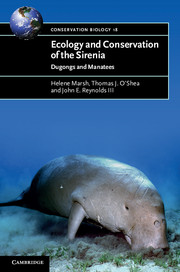Book contents
- Frontmatter
- Contents
- Foreword
- Preface
- Acknowledgements
- 1 Introduction
- 2 Steller’s sea cow
- 3 Affinities, origins and diversity of the Sirenia through time
- 4 Feeding biology
- 5 Behaviour and habitat use
- 6 Life history, reproductive biology and population dynamics
- 7 Threats
- 8 Conservation status
- 9 Conservation opportunities
- References
- List of online supplementary material
- Index
- Plate section
7 - Threats
Published online by Cambridge University Press: 05 January 2012
- Frontmatter
- Contents
- Foreword
- Preface
- Acknowledgements
- 1 Introduction
- 2 Steller’s sea cow
- 3 Affinities, origins and diversity of the Sirenia through time
- 4 Feeding biology
- 5 Behaviour and habitat use
- 6 Life history, reproductive biology and population dynamics
- 7 Threats
- 8 Conservation status
- 9 Conservation opportunities
- References
- List of online supplementary material
- Index
- Plate section
Summary
Introduction
The population biology of sirenians renders them particularly vulnerable to mortality as adults (Chapter 6). Threats to sirenians in various parts of the world have been documented extensively, especially those threats that cause death. In addition to ensuring the existence of adequate habitat, conservation of sirenian populations (Chapters 8 and 9) must include measures to reduce these threats and thereby facilitate the recovery of depleted populations. In this chapter we categorise and review the range of factors known to threaten sirenian populations, including those that are directly caused by humans and natural threats, and several that blur the line between these two categories: naturally occurring threats that are exacerbated by anthropogenic factors. Human-caused direct threats include hunting, incidental killing in fisheries, collisions with boats and ships and a variety of lesser known factors that can have cumulative impacts. Natural factors are limited to biotic threats such as predation (Chapter 5), severe climatic events, infectious diseases and macroparasites. Diseases and parasites can operate in a density-dependent fashion, and their roles in population dynamics of marine mammals are not well understood. However, disease outbreaks can be devastating to small and isolated populations, and a background summary of what is known about diseases in sirenians is of importance for conservation planning. The dangers posed by diseases are not entirely natural: anthropogenic factors can stress populations, possibly affect immune system function and induce greater susceptibility to disease, and unwitting release or translocation of infected individuals can wreak havoc on immunologically naïve populations. Other naturally occurring threats that are exacerbated by anthropogenic factors include poisonings by harmful algal blooms and biotoxins, and cold stress near the margins of sirenian distributions. All these threats are operating against a backdrop of rising human population densities, future environmental degradation expected with global climate change, and an existing or potential loss of genetic diversity that may hamper the capability of sirenian populations to adapt over the long-term.
- Type
- Chapter
- Information
- Ecology and Conservation of the SireniaDugongs and Manatees, pp. 263 - 326Publisher: Cambridge University PressPrint publication year: 2011



